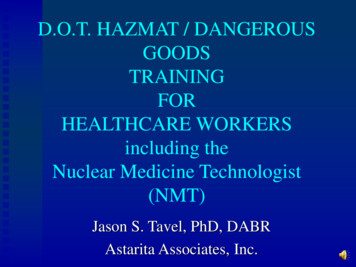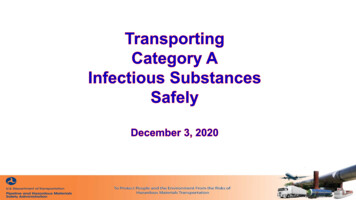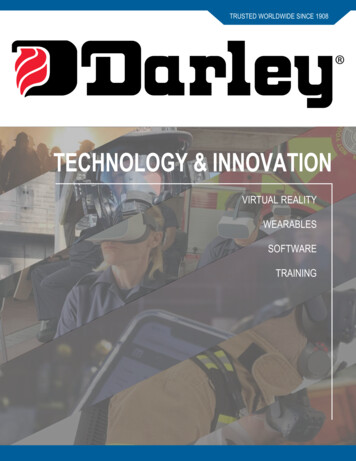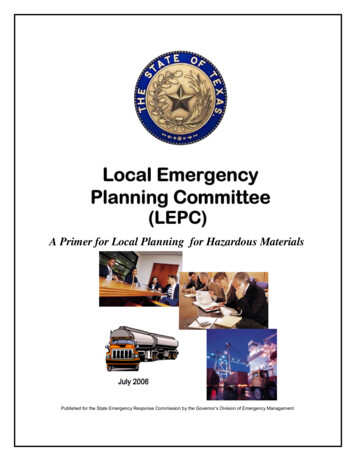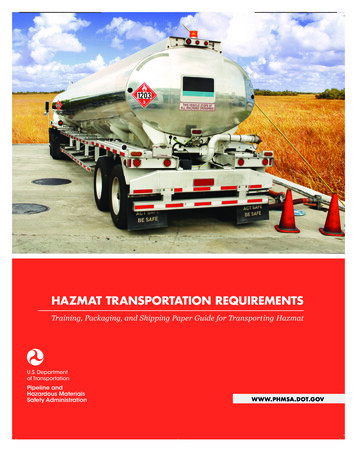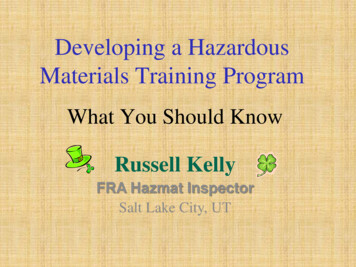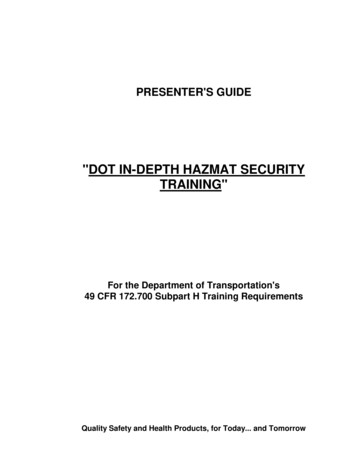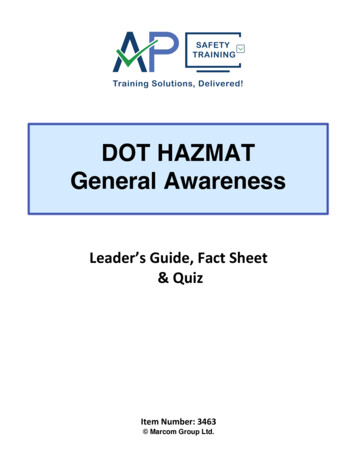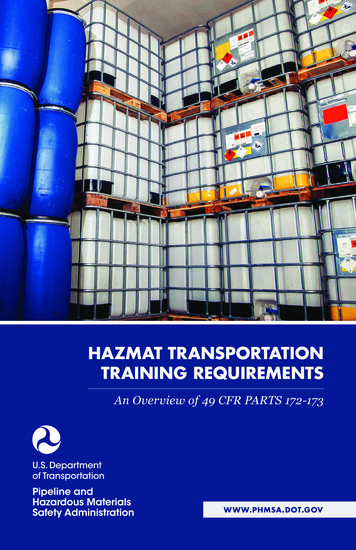
Transcription
HAZMAT TRANSPORTATIONTRAINING REQUIREMENTSAn Overview of 49 CFR PARTS 172-173WWW.PHMSA.DOT.GOV1PHMSA PIPELINE AND HAZARDOUS MATERIALS SAFETY ADMINISTRATION
In this guide you will find detailson training regulations as well asdefinitions of terminology found inthe HMR, such as hazmat employerand hazmat employee. There are alsoanswers to the most frequently askedquestions about hazmat transportationtraining requirements. Complying withthese regulations can help you transporthazmat more safely, and avoidunnecessary penalties.2
IT'S THE LAWTraining is the best means of preventing, or reducing, hazardousmaterials (hazmat) incidents in transportation that are caused byhuman error.The Federal hazardous materials transportation law (49 U.S.C. 5101,et seq.) is the statute pertaining to the transportation of hazmat in theUnited States, and requires the training of ALL hazmat employees.The purpose of this training is to increase a hazmat employee’s safetyawareness and to be an essential element in reducing hazmat incidents.The Hazardous Materials Regulations (HMR) includes trainingrequirements in several sections of Title 49 Code of Federal Regulations(CFR) as follows: GENERAL SPECIFIC MODAL Air Vessel , 177.816Receiving the required training enhances employee safety and security,and increases employee productivity and skills. Effective training alsoreduces incidents and accidents thereby reducing operating costs andlosses from property damage, thus increasing profits.PHMSA PIPELINE AND HAZARDOUS MATERIALS SAFETY ADMINISTRATION3
HMR TRAINING REQUIREMENTSEach hazmat employer must train and test their hazmat employees,certify their training, and develop and retain records of current training.Hazmat training must include, or be: general ;security awareness;in-depth security training, if a security plan is required; anddriver training (for each hazmat employee who will operatea motor vehicle).FREQUENCY OF TRAININGInitial training of new hazmat employees, or an employee who changesjob functions, must be completed within 90 days of employment orchange in job function. A new employee may perform hazmat jobfunctions before completing training provided the employee does sounder the direct supervision of a properly trained and knowledgeablehazmat employee.Recurrent training is required at least once every three years. The threeyear period begins on the actual date of training. Relevant trainingreceived from a previous employer or source may be used to satisfy therequirements provided a current record of training is obtained from theprevious employer or other sources.4
Training conducted by OSHA, EPA, and other Federal or internationalagencies may be used to satisfy the training requirements in §172.704(a)to the extent that such training addresses the components specifiedin paragraph (a) of this section (general awareness/familiarization;function-specific; safety; security awareness; in-depth security training,if a security plan is required; and driver training for each hazmatemployee who will operate a motor vehicle).TRAINING RECORDSTraining records must be kept by the hazmat employer for each hazmatemployee, and must include the following: the hazmat employee’s name;the completion date of the most recent training;training materials used (copy, description, or location);the name and address of the hazmat trainer; andcertification that the hazmat employee has been trained and tested.Training records must be retained for each hazmat employee for threeyears from the date of the last training, and for 90 days after theemployee leaves.PHMSA PIPELINE AND HAZARDOUS MATERIALS SAFETY ADMINISTRATION5
The following terms are defined insection 171.8 of the HMR. They willhelp you better understand the hazmattransportation training requirements—particularly your responsibilities.6
DEFINITIONSTraining - a systematic program (consistent approach, testing, anddocumentation) that ensures a hazmat employee has knowledge ofhazmat and the HMR, and can perform assigned hazmat functionsproperly. See §172.700 through §172.704.Hazmat employer - a person who uses one or more employeesregarding: transporting hazmat in commerce; causing hazmat to be transported or shipped in commerce; or designing, manufacturing, fabricating, inspecting, representing,marking, certifying, selling, offering, reconditioning,testing, repairing, or modifying packagings as qualified for use inthe transportation of hazmat.The term “hazmat employer” also includes any department, agency,or instrumentality of the United States, a State, a political subdivisionof a State, or Native American Indian tribe engaged in offering ortransporting hazmat in commerce. This term includes a person whois self-employed, including an owner-operator of a motor vehicle thattransports hazmat in commerce.Hazmat employee - a person employed by a hazmat employer,or person who is self-employed, and who directly affects hazmattransportation safety including: an owner-operator of a motor vehicle that transports hazmat; a person who: loads, unloads, or handles hazmat; designs, manufactures, fabricates, inspects, tests, reconditions,repairs, modifies, marks, or otherwise represents packagingsas qualified for use in the transportation of hazmat; prepares hazmat for transportation; is responsible for safety of transporting hazmat; or operates a vehicle used to transport hazmat.PHMSA PIPELINE AND HAZARDOUS MATERIALS SAFETY ADMINISTRATION7
FREQUENTLY ASKED QUESTIONSQ:May hazmat employers/employees train and test themselves (anowner-operator)?A:Yes, self-training is acceptable provided that all trainingrequirements of §172.704 are met.Q:Who certifies that an instructor is qualified to train, test, andcertify in accordance with §172.704?A:Except for certain FAA-required 14 CFR training, the U.S. DOTdoes not review or certify training programs for pre-approvalpurposes. The employer must determine a trainer’squalifications based on the employer’s needs.Q:Does the trainer who teaches and tests the hazmat employeecertify that the hazmat employee is trained and tested?A:It is the hazmat employer’s responsibility to ensure that ahazmat employee is properly trained and tested; however, thehazmat employer may designate an outside source to train, test,and certify on his/her behalf that the employee has been trainedand tested.Q:If a designated outside source trains but does not test theemployee, must the employee be tested to complete this training?A:Yes. The employee must be tested in order for the training tomeet the requirements of the HMR. The hazmat employer isresponsible for ensuring each hazmat employee is trained andtested.8
Q:Must the test be in a written format or may a skill demonstrationbe used?A:Any test that ensures that the employee can perform theassigned duties in compliance with the HMR is acceptable.Training and testing may be accomplished in a variety of ways:performance, written, verbal, or a combination of these.Q:Must the employee “pass” a test?A:The requirements do not state that the employee must “pass” atest; however, an employee may only be certified in areas inwhich he/she can successfully perform his/her hazmat duties.Q:Does IMDG Code, ICAO Technical Instructions, OSHA, or EPAtraining fulfill the HMR requirements?A:This training may be used to the extent that the generalawareness, function-specific, safety, and security trainingand testing requirements of the HMR are met. Areas notcovered will require additional training.Q:Who will enforce the training requirements in §172.704?A:Enforcement is the responsibility of each U.S. DOT modaladministration. Compliance or noncompliance with the trainingrule will be determined during safety and compliance reviews ofshippers, carriers, and package manufacturers.PHMSA PIPELINE AND HAZARDOUS MATERIALS SAFETY ADMINISTRATION9
Q:What type of fines would be involved?A:Violations of any hazmat regulations including training maybe subject to a civil penalty of up to 77,114 for each violation.If the violation results in death, serious illness, or severe injuryto any person or substantial destruction of property, themaximum civil penalty is 179,933. The minimum civil penaltyamount for a training violation is 463. Criminal violationsmay result in fines, imprisonment, or both. (See 49 CFR §107.329and §107.333.)Q:An office secretary types the required hazmat description on ashipping paper at the direction of another, item by item. Is thesecretary considered to be a hazmat employee requiringtraining?A:Yes. Any person who performs a function subject to theHMR must be trained, except for special circumstancesaddressed by §172.704(e).Q:Do the hazmat training regulations apply to foreign flag vesselscarrying hazmat?A:Yes. The regulations apply to each non-bulk domestic andforeign vessel while operating in navigable waters of the UnitedStates.Q:Do the hazmat training regulations apply to hazmat employersand/or employees who operate a bulk vessel transportinghazmat?A:No. Except for transportation in bulk packagings, the bulkcarriage of hazmat by water is governed by 46 CFR Chapter I,Subchapters D, I, N, and O. See 49 CFR §176.5(d).Q:Is a ship’s master a hazmat employer?A:No. The ship master is a hazmat employee; the operator of thevessel is the hazmat employer.10
Q:Do hazmat training regulations apply to employees working withmaterials that are consumer commodities?A:Yes. Consumer commodities are listed as ORM-D in thehazardous materials table §172.101.Q:Does a Commercial Driver’s License (CDL) with HM/tankvehicle endorsement satisfy requirements?A:A hazmat employer must determine applicability of CDL tothe specific functions the employee performs and providetraining for functions not covered by the endorsement.Q:Does an individual (non-business/private citizen) need hazmattraining to ship via common carrier (UPS, Fed EX, etc.)?A:No. Individuals shipping hazmat by common carrier are notrequired to meet the training requirements under 49 CFR Part172 Subpart H unless they are a “hazmat employee” as definedin §171.8; however, they are responsible for ensuring that theshipment is prepared in accordance with the HazardousMaterials Regulations.Q:Our hazmat employees have training to ship materials byground. Are they authorized to ship packages by air or water,also?A:No. Hazmat employees that usually prepare shipments fortransportation via highway may not have sufficient trainingto ship hazmat via other modes of transportation. Trainedhazmat employees should be generally aware of the requirementsfor shipping hazmat via all modes of transportation, but mayneed additional function-specific training (i.e., modal-specifictraining) in order to comply with the HMR.PHMSA PIPELINE AND HAZARDOUS MATERIALS SAFETY ADMINISTRATION11
For additional information contact:The Hazardous Materials Info Center1-800-HMR-4922(1-800-467-4922)Email: infocntr@dot.govhttp://hazmat.dot.govPipeline and Hazardous Materials Safety AdministrationOutreach, Training, and Grants DivisionEast Building, 2nd Floor1200 New Jersey Ave., SEWashington, DC 20590Email: training@dot.gov202-366-4900202-366-7342 (Fax)12PHH50-0158-1016
8 FREQUENTLY ASKED QUESTIONS Q: May hazmat employers/employees train and test themselves (an owner-operator)? A: Yes, self-training is acceptable provided that all training requirements of §172.704 are met. Q: Who certifies that an instructor is qualified to train, test, and certify in accordance with §172.704? A: Except for certain FAA-required 14 CFR training, the U.S. DOT
